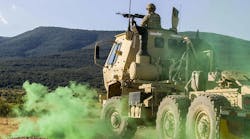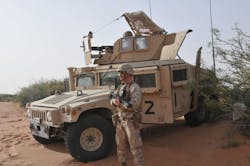Comtech Telecommunications Corp. announced that its Command and Control Technologies group, through its Maryland-based subsidiary, Comtech Mobile Datacom Corporation, was awarded an initial $11.7 million order to immediately provide several thousand of its MT-2025 mobile satellite transceivers to support the U.S. Army’s second-generation Blue Force Tracking (BFT-2) network. The BFT-2 system is part of the Army’s Joint Battle Command Platform (JPC-P) program and is designed to provide real-time situational awareness and networking capabilities for U.S. warfighters. Comtech expects to begin shipments during the second half of its fiscal 2018.
The BFT-2 network is a situational awareness system for the U.S. Army and Marine Corps Blue Force Tracking network. The second-generation version of the network is designed for bring high-capacity, low-latency communications and situational awareness to warfighters in combat vehicles and rotary-wing aircraft (see figure). The capacity of the second-generation network is estimated to be much greater than that of the existing BFT system, with data transfers occurring in seconds rather than minutes.
The U.S. Army’s second-generation Blue Force Tracking (BFT-2) satellite network will be improving performance as a result of some new vehicle-mounted L-band radio transceivers.
The MT-2025 transceiver vehicle satellite transceiver is tested to MIL-STD-810F and MIL-STD-461F requirements and is a full-duplex system capable of supporting military GPS. It provides secure and reliable two-way messaging at L-band frequencies, delivering data rates to 131 kb/s. The radio transmits at 1,610.0 to 1,660.5 MHz and receives at 1,525 to 1,559 MHz. It uses an internal omnidirectional antenna to maximize signal acquisition, and supports right-handed circular polarization (RHCP) and left-handed circular polarization (LHCP) satellite constellations.
“I am delighted that the U.S. Army has chosen us to meet their immediate operational needs,” said Fred Kornberg, Comtech president and CEO. “The Army has Comtech’s full commitment in supporting both the BFT-1 and BFT-2 requirements. I look forward to delivering this initial and other orders well into the future.” The company currently provides sustaining support for the BFT-1 system, having previously shipped more than 100,000 BFT-1 mobile satellite transceivers.


